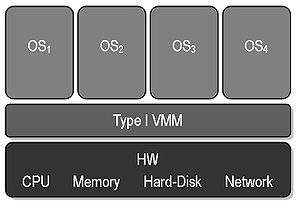- Schematic diagram of a Virtual Machine setup. The physical hardware is at the bottom, the virtual machine monitor (VMM) sits in the middle, and multiple actual virtual machines sit on top of the VMM. Image via Wikipedia
(This post by Dilip Ranade on his blog, takes a look at how Virtual Machines are going to change the way we do computing, and also how we will start using virtual machines in new and interesting ways as they mature. It is republished from there here with permission.)
Synopsis: some thoughts on the impact of virtual machines
Virtual Machines were invented in IBM in the early seventies , but it appears that it was only VMWare started much later in 1998 that figured out how to make money purely out of virtualization. However, with Xen and Microsoft Virtual Server also entering the fray, things are getting interesting. The green pastures of Virtual Machines, often misnamed virtualization (which is actually
a broader term) now appear poised to support a large herd of bulls.
Although it is hard to predict all the ways in which a new technology will change the world– think of telephones and sex hotlines for example — here are some thoughts on how VM’s can have an unforeseen impact, arranged roughly in order of increasing ambitiousness:
- VM’s can break the HW/SW Red Queen Effect
- VM’s can break vendor “lock-in”
- Processors can become commoditized
- Operating systems can become commoditized
- Rise of virtual appliances
- Rise of virtual machine swarms
VM’s can Break the HW/SW Red Queen Effect.
Software vendors and hardware vendors are in a mutually beneficial race, leading to an exponential spiral: customers are forced to buy ever more powerful computers to run ever more resource-hogging versions of software. But with a Virtual Machine this collusion can be broken. First of all, customers will balk at buying bloated software, as happened with Microsoft Vista. Secondly, marginally bloated software can be tolerated without having to replace the virtual servers with more powerful machines. For example, a VM can
be virtually upgraded to larger memory or more CPUs without making new purchases.
Thus, the existence of virtualized servers brings genuine economic pressure for software developers to be more frugal with CPU and memory consumption in their products. This works in conjunction with the next point.
VM’s can Break Vendor “lock-in”
When a software product is on a virtual machine, it is easy and non disruptive to try
out a competing product on another virtual machine, even if it
requires different type of hardware. However, this effect is not as powerful
as it can potentially be, because todays virtualization is too focused to x86
architecture.
Processors can Become Commoditized
The time is ripe for the evolution of a standard virtual processor,
just like TCP/IP is for network protocols. Consider the advantages: Considerably reduced development and testing costs (write once run anywhere); potentially longer software product life (delinked from hardware obsolescence); clean room environment for “dusty decks” (very old software can continue to run in a virtual environment). I am thinking of a more abstract kind of virtual processor that is also extensible or mutable in ways that hardware processors cannot be. It may not need to make hard choices between various hardware tradeoffs.
The Java virtual machine is an example.
Operating Systems can Become Commoditized
As the virtual processor evolves towards higher levels of
abstraction, so should virtual devices that it connects to. This should reduce the complexity of the virtual operating system; then it should not need a team consisting of thousands of progammers to maintain a virtual operating system.
For example, a virtual OS does not need bootstrapping code – it can boot of a virtual network boot service. Similarly, there is no need for every virtual Operating system to implement its own file system and to interact only with (virtual) hard disks. All it needs is a simple file system client to discover and connect to the correct virtual Network Attached Storage (NAS) devices.
Rise of Virtual Appliances
General-purpose operating systems can be replaced with lean-and-mean
tailor-made variants designed for specific applications. For example
an OS built specifically for a web server, or different one for a
database.
Rise of Virtual Machine Swarms
The trend towards multi-core, multi-thread programming can be fitted
better to a virtual machine designed to work in swarms. The Transputer of late 1980’s comes to
mind: multiprocessor meshes could be built from multiple Transputers just by physically connecting built-in serial links between pairs of Transputers. The
standard virtual processor’s simple network interconnect could support
easy interfacing within a swarm. I think PVM and grid computing concepts can be considered precursors of VM swarms.
About the Author – Dilip Ranade
For more information, see his linked-in profile.
Related articles by Zemanta
- HELIOS UB+ adds Support for VMware, Microsoft, and IBM server Virtualization (seomashup.blogspot.com)
- Has The Virtualization Future Arrived? (codinghorror.com)
- What can you expect from a cloud? (blogs.sun.com)
- Managing Virtual Infrastructures With PowerShell (slideshare.net)
- Update: VMware adds to cloud strategy (infoworld.com)
- The Beginner’s Guide to Creating Virtual Machines with VirtualBox [How-to] (lifehacker.com)
Comments are closed on this post. If you have any comments, please leave them at the original article.

![Reblog this post [with Zemanta]](http://img.zemanta.com/reblog_b.png?x-id=46bb08d3-69f4-4541-98b6-29189b874b69)